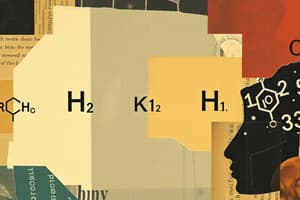Podcast
Questions and Answers
What are alkyl halides classified as?
What are alkyl halides classified as?
- Primary (1°)
- Secondary (2°)
- Tertiary (3°)
- All of the above (correct)
What is an ether?
What is an ether?
A functional group that consists of an oxygen bonded to 2 carbons (R-O-R).
What is a functional group?
What is a functional group?
An atom or a group of atoms with characteristic chemical and physical properties.
What characterizes a carboxylic acid?
What characterizes a carboxylic acid?
What is the general structure of alcohols?
What is the general structure of alcohols?
What defines a ketone?
What defines a ketone?
What is an ester?
What is an ester?
What is a carbonyl?
What is a carbonyl?
What is an aldehyde?
What is an aldehyde?
What defines an amine?
What defines an amine?
What characterizes an amide?
What characterizes an amide?
What defines an alkene?
What defines an alkene?
What defines an alkyne?
What defines an alkyne?
What does aromatic mean in organic chemistry?
What does aromatic mean in organic chemistry?
Match the terms related to functional groups with their definitions:
Match the terms related to functional groups with their definitions:
What are the key rules for naming functional groups?
What are the key rules for naming functional groups?
Flashcards are hidden until you start studying
Study Notes
Functional Groups Overview
- Functional groups are specific groups of atoms within molecules that have distinctive chemical properties and determine the reactivity of compounds.
Alkyl Halide
- Composed of a halogen atom 'X' attached to an sp3 hybridized carbon.
- Classified as primary (1°), secondary (2°), or tertiary (3°) based on the number of carbons linked to the carbon with a halogen.
- Derives from alkanes by replacing hydrogen with a halogen, using naming conventions that change "-ine" to "-o".
Ether
- Defined as R-O-R, where oxygen is bonded to two carbons (R-groups).
- Classified into symmetric (identical groups) and asymmetric (different groups) ethers.
- Naming involves recognizing the longest carbon chain and treating the O-R fragment as a substituent, appending "-oxy" to the parent alkane name.
Carboxylic Acid
- Contains a carboxyl group (COOH) featuring a carbonyl (C=O) and hydroxyl (OH) group.
- Exhibits unique chemical properties due to the presence of the carboxyl functional group.
Alcohol
- Characterized by the general structure ROH with a hydroxy group (OH) attached to an sp3 hybridized carbon.
- Classified as primary (1°), secondary (2°), or tertiary (3°), similar to alkyl halides.
- Naming convention replaces "-e" in the hydrocarbon with "-ol".
Ketone
- Features a carbonyl group (C=O) with two alkyl groups (R) attached, having structures of R2C=O or RCOR'.
Ester
- Derived from the reaction of a carboxylic acid and an alcohol, characterized by the replacement of the acidic OH with an OR group.
- Contains a carbonyl group but lacks acidic hydrogen, giving it distinct properties compared to carboxylic acids and ethers.
Carbonyl
- Consists of a carbon-oxygen double bond (C=O).
- The polar character of the bond renders the carbonyl carbon electrophilic, making it reactive in various chemical reactions.
Aldehyde
- Contains a formyl group (R-CHO), which is a carbonyl attached to a hydrogen and an R group.
- Serves as a vital functional group with implications in organic synthesis.
Amine
- Compounds formed by the replacement of one or more hydrogens in ammonia by alkyl groups.
- Classified as primary (1°), secondary (2°), or tertiary (3°) based on the number of carbon substituents on the nitrogen.
- Named by changing the hydrocarbon suffix from "-e" to "amine".
Amide
- Represents organic compounds featuring a carbonyl bond to nitrogen (C=O-N).
- Formed from reactions between carboxylic acids and amines, playing a key role in biological systems.
Alkene
- An aliphatic hydrocarbon characterized by a carbon-carbon double bond.
- Naming involves changing the suffix from "-ane" to "-ene".
Alkyne
- Another aliphatic hydrocarbon distinguished by a carbon-carbon triple bond.
Aromatic
- Refers to compounds containing benzene (C6H6), a cyclic hydrocarbon known for its stability and distinct reactivity due to resonance.
Rules for Naming Functional Groups
- Identify the longest continuous chain containing the functional group as the parent hydrocarbon.
- Number the chain to assign the functional group the lowest possible number; no number is needed if the group is on a ring.
- If a functional group and substituent coexist, the functional group gets priority in numbering.
- When numbering results in identical positions, ensure substituents receive the next lowest possible numbers.
- List multiple substituents in alphabetical order to adhere to systematic naming conventions.
Studying That Suits You
Use AI to generate personalized quizzes and flashcards to suit your learning preferences.




